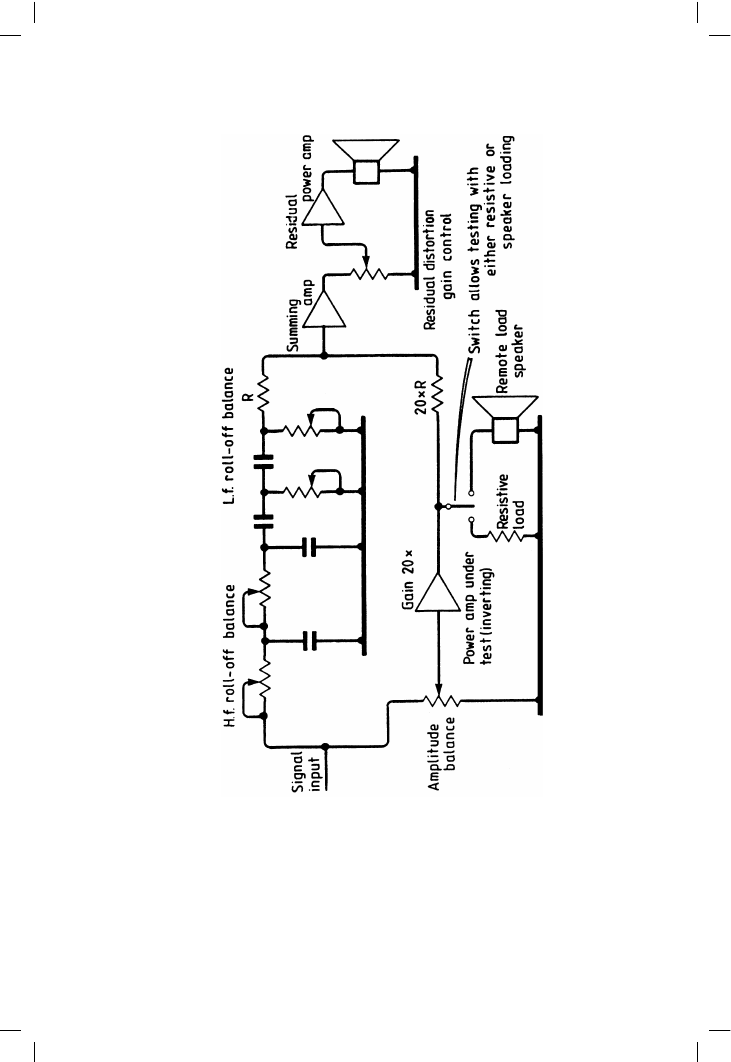ВУЗ: Казахская Национальная Академия Искусств им. Т. Жургенова
Категория: Учебное пособие
Дисциплина: Не указана
Добавлен: 03.02.2019
Просмотров: 17352
Скачиваний: 18

Introduction and general survey
Negative feedback is not inherently a bad thing; it is an absolutely
indispensable principle of electronic design, and if used properly has the
remarkable ability to make just about every parameter better. It is usually
global feedback that the critic has in mind. Local negative feedback is
grudgingly regarded as acceptable, probably because making a circuit
with no feedback of any kind is near-impossible. It is often said that high
levels of NFB enforce a low slew-rate. This is quite untrue; and this
thorny issue is dealt with in detail on page 46. For more on slew-rate see
also
[15]
.
!
Tone-controls cause an audible deterioration even when set to the flat
position.
This is usually blamed on phase-shift. At the time of writing, tone controls
on a pre-amp badly damage its chances of street (or rather sitting-room)
credibility, for no good reason. Tone-controls set to flat cannot possibly
contribute any extra phase-shift and must be inaudible. My view is that they
are absolutely indispensable for correcting room acoustics, loudspeaker
shortcomings, or tonal balance of the source material, and that a lot of
people are suffering sub-optimal sound as a result of this fashion. It is now
commonplace for audio critics to suggest that frequency-response inade-
quacies should be corrected by changing loudspeakers. This is an
extraordinarily expensive way of avoiding tone-controls.
!
The design of the power supply has subtle effects on the sound, quite
apart from ordinary dangers like ripple injection.
All good amplifier stages ignore imperfections in their power supplies, op-
amps in particular excelling at power-supply rejection-ratio. More non-
sense has been written on the subject of subtle PSU failings than on most
audio topics; recommendations of hard-wiring the mains or using gold-
plated 13 A plugs would seem to hold no residual shred of rationality, in
view of the usual processes of rectification and smoothing that the raw AC
undergoes. And where do you stop? At the local sub-station? Should we
gold-plate the pylons?
!
Monobloc construction (i.e. two separate power amplifier boxes) is
always audibly superior, due to the reduction in crosstalk.
There is no need to go to the expense of monobloc power amplifiers in
order to keep crosstalk under control, even when making it substantially
better than the –20 dB that is actually necessary. The techniques are
conventional; the last stereo power amplifier I designed managed an easy
–90 dB at 10 kHz without anything other than the usual precautions. In this
area dedicated followers of fashion pay dearly for the privilege, as the cost
of the mechanical parts will be nearly doubled.
!
Microphony is an important factor in the sound of an amplifier, so any
attempt at vibration-damping is a good idea.
15

Audio Power Amplifier Design Handbook
Microphony is essentially something that happens in sensitive valve pre-
amplifiers, If it happens in solid-state power amplifiers the level is so far
below the noise it is effectively non-existent.
Experiments on this sort of thing are rare (if not unheard of) and so I offer
the only scrap of evidence I have. Take a microphone pre-amp operating at
a gain of +70 dB, and tap the input capacitors (assumed electrolytic)
sharply with a screwdriver; the pre-amp output will be a dull thump, at low
level. The physical impact on the electrolytics (the only components that
show this effect) is hugely greater than that of any acoustic vibration; and
I think the effect in power amps, if any, must be so vanishingly small that
it could never be found under the inherent circuit noise.
Let us for a moment assume that some or all of the above hypotheses are
true, and explore the implications. The effects are not detectable by
conventional measurement, but are assumed to be audible. Firstly, it can
presumably be taken as axiomatic that for each audible defect some
change occurs in the pattern of pressure fluctuations reaching the ears, and
therefore a corresponding modification has occurred to the electrical signal
passing through the amplifier. Any other starting point supposes that there
is some other route conveying information apart from the electrical signals,
and we are faced with magic or forces-unknown-to-science. Mercifully no
commentator has (so far) suggested this. Hence there must be defects in the
audio signals, but they are not revealed by the usual test methods. How
could this situation exist? There seem two possible explanations for this
failure of detection: one is that the standard measurements are relevant, but
of insufficient resolution, and we should be measuring frequency response,
etc. to thousandths of a dB. There is no evidence whatsoever that such
micro-deviations are audible under any circumstances.
An alternative (and more popular) explanation is that standard sinewave
THD measurements miss the point by failing to excite subtle distortion
mechanisms that are triggered only by music, the spoken word, or
whatever. This assumes that these music-only distortions are also left
undisturbed by multi-tone intermodulation tests, and even the complex
pseudorandom signals used in the Belcher distortion test
[16]
. The Belcher
method effectively tests the audio path at all frequencies at once, and it is
hard to conceive of a real defect that could escape it.
The most positive proof that subjectivism is fallacious is given by
subtraction testing. This is the devastatingly simple technique of subtracting
before-and-after amplifier signals and demonstrating that nothing audibly
detectable remains.
It transpires that these alleged music-only mechanisms are not even
revealed by music, or indeed anything else, and it appears the subtraction
test has finally shown as non-existent these elusive degradation
mechanisms.
16

Figure
1.3
Baxandall
cancellation
technique
17

Audio Power Amplifier Design Handbook
The subtraction technique was proposed by Baxandall in 1977
[17]
. The
principle is shown in Figure 1.3; careful adjustment of the rolloff-balance
network prevents minor bandwidth variations from swamping the true
distortion residual. In the intervening years the Subjectivist camp has made
no effective reply.
A simplified version of the test was introduced by Hafler
[18]
. This method
is less sensitive, but has the advantage that there is less electronics in the
signal path for anyone to argue about. See Figure 1.4. A prominent
Subjectivist reviewer, on trying this demonstration, was reduced to
claiming that the passive switchbox used to implement the Hafler test was
causing so much sonic degradation that all amplifier performance was
swamped
[19]
. I do not feel that this is a tenable position. So far all
experiments such as these have been ignored or brushed aside by the
Subjectivist camp; no attempt has been made to answer the extremely
serious objections that this demonstration raises.
In the twenty or so years that have elapsed since the emergence of the
Subjectivist Tendency, no hitherto unsuspected parameters of audio quality
have emerged.
The length of the audio chain
An apparently insurmountable objection to the existence of non-measur-
able amplifier quirks is that recorded sound of almost any pedigree has
passed through a complex mixing console at least once; prominent parts
like vocals or lead guitar will almost certainly have passed through at least
twice, once for recording and once at mix-down. More significantly, it must
have passed through the potential quality-bottleneck of an analogue tape
machine or more likely the A–D converters of digital equipment. In its long
path from here to ear the audio passes through at least a hundred op-amps,
dozens of connectors and several hundred metres of ordinary screened
cable. If mystical degradations can occur, it defies reason to insist that those
introduced by the last 1% of the path are the critical ones.
18
Figure 1.4
Hafler straight-wire
differential test

Introduction and general survey
The implications
This confused state of amplifier criticism has negative consequences.
Firstly, if equipment is reviewed with results that appear arbitrary, and
which are in particular incapable of replication or confirmation, this can be
grossly unfair to manufacturers who lose out in the lottery. Since subjective
assessments cannot be replicated, the commercial success of a given make
can depend entirely on the vagaries of fashion. While this is fine in the
realm of clothing or soft furnishings, the hi-fi business is still claiming
accuracy of reproduction as its raison d’ˆetre, and therefore you would
expect the technical element to be dominant.
A second consequence of placing subjectivism above measurements is that
it places designers in a most unenviable position. No degree of ingenuity or
attention to technical detail can ensure a good review, and the pressure to
adopt fashionable and expensive expedients (such as linear-crystal internal
wiring) is great, even if the designer is certain that they have no audible
effect for good or evil. Designers are faced with a choice between
swallowing the Subjectivist credo whole or keeping very quiet and leaving
the talking to the marketing department.
If objective measurements are disregarded, it is inevitable that poor
amplifiers will be produced, some so bad that their defects are unquestion-
ably audible. In recent reviews
[20]
it was easy to find a £795 pre-amplifier
(Counterpoint SA7) that boasted a feeble 12 dB disc overload margin,
(another pre-amp costing £2040 struggled up to 15 dB (Burmester 838/846)
and another, costing £1550 that could only manage a 1 kHz distortion
performance of 1%; a lack of linearity that would have caused consterna-
tion ten years ago (Quicksilver). However, by paying £5700 one could inch
this down to 0.3% (Audio Research M100–2 monoblocs). This does not of
course mean that it is impossible to buy an audiophile amplifier that does
measure well; another example would be the pre-amplifier/power amplifier
combination that provides a very respectable disc overload margin of 31 dB
and 1 kHz rated-power distortion below 0.003%; the total cost being £725
(Audiolab 8000C/8000P). I believe this to be a representative sample, and
we appear to be in the paradoxical situation that the most expensive
equipment provides the worst objective performance. Whatever the rights
and wrongs of subjective assessment, I think that most people would agree
that this is a strange state of affairs. Finally, it is surely a morally ambiguous
position to persuade non-technical people that to get a really good sound
they have to buy £2000 pre-amps and so on, when both technical
orthodoxy and common sense indicate that this is quite unnecessary.
The reasons why
Some tentative conclusions are possible as to why hi-fi engineering has
reached the pass that it has. I believe one basic reason is the difficulty of
defining the quality of an audio experience; you can’t draw a diagram to
19